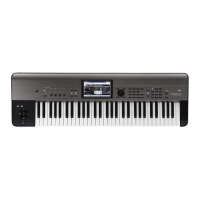PROG P2: OSC/Pitch 2–3: OSC1 Pitch
21
Pitch Slope, pitch, and note
Positive (+) values cause the pitch to rise as you play higher
on the keyboard, and negative (–) values cause the pitch to
fall as you play higher on the keyboard.
When this is set to 0, playing different notes on the keyboard
won’t change the pitch at all; it will be as if you’re always
playing C4. This can be useful for special effects sounds, for
instance.
Ribbon [–12...+12]
Specify in semitones how the pitch will change when CC#16
is received.
With a positive (+) setting, the pitch will rise when the value
of CC#16 is higher than the center value of 64. With a
negative (–) setting, the pitch will fall.
JS (+X) [–60...+12]
Specify in semitones how the pitch will change when the
joystick is moved to the right (or when a pitch bend message
is received). For normal pitch bend, set this to a positive
value.
For example, if you set this to +12 and move the joystick all
the way to the right, the pitch will rise one octave above the
original pitch.
JS (–X) [–60...+12]
Specify in semitones how the pitch will change when the
joystick is moved to the left (or when a pitch bend message
is received). For normal pitch bend, set this to a negative
value.
For example, if you set this to –60 and move the joystick all
the way to the left, the pitch will fall five octaves below the
original pitch. You can use this to create guitar‐style
downward swoops.
AMS (Pitch) [List of AMS Sources]
This selects a AMS source to control the pitch. For a list of
AMS sources, please see “AMS (Alternate Modulation
Source) List” on page 340.
Intensity [–12.00...+12.00]
This controls the depth and direction of the pitch
modulation, in semitones.
For example if you set AMS (Pitch) to JS+Y: CC#01 and then
move the joystick in the +Y direction, the pitch will rise if
this parameter is set to a positive (+) value, or fall if this
parameter is set to a negative (–) value.
2–3b: Pitch EG
Intensity [–12.00...+12.00]
This controls the initial effect of the Pitch EG on Oscillator
1’s frequency, in half‐steps, before any AMS modulation.
The Pitch EG’s shape can swing all the way from +99 to –99.
When the Intensity is set to a positive (+) value, positive
values from the EG raise the pitch, and negative values
lower the pitch.
When the Intensity is set to a negative (–) value, the effect of
the EG is reversed; positive EG values mean lower pitches,
and negative EG values mean higher pitches.
AMS (Pitch EG) [List of AMS Sources]
This selects any AMS modulation source to scale the amount
of the Pitch EG.
For a list of AMS sources, please see “AMS (Alternate
Modulation Source) List” on page 340.
Intensity [–12.00...+12.00]
This controls the depth and direction of the pitch EG AMS
modulation. The AMS modulation and the initial Intensity
are added together to determine the Pitch EG’s final effect.
With positive (+) values, greater modulation will increase
the effect of the Pitch EG, as shown in example B below.
With negative (–) values, greater modulation will introduce
the opposite effect of the Pitch EG–like inverting the polarity
of the envelope. You can use this in several different ways:
• You can set an initial positive amount with the Intensity
parameter, and then reduce this amount with AMS. In
this case, the final effect of the EG is simply diminished,
and not actually inverted, as shown in example C.
• You can also set the AMS Intensity amount to be greater
than the initial Intensity. In this case, the EG will have a
positive effect with low modulation amounts, and an
inverted effect at higher modulation amounts as shown in
example D.
Pitch EG AMS
2–3c: Portamento
Portamento lets the pitch glide smoothly between notes,
instead of changing abruptly.
Enable [Off, On]
On (checked): Turns on Portamento, so that pitch glides
smoothly between notes.
Off (unchecked): Turns off Portamento. This is the default
state.
Fingered [Off, On]
This parameter allows you to control Portamento through
your playing style. When it’s enabled, playing legato will
turn on Portamento, and playing detached will turn it off
again.
This option is only available when Portamento Enable is
turned on.
On (checked): Turns on Fingered Portamento.
Off (unchecked): Turns off Fingered Portamento.
Mode [Rate, Time]
Rate means that Portamento will always take the same
amount of time to glide a given distance in pitch ‐ for
instance, one second per octave. Put another way, gliding
Pitch
Note on keyboard
2oct
1oct
1oct
C4 C5
+2
+1
0
–1
Change
to Pitch
Change
to Pitch
A. Original EG B. Intensity = +6.00
C. Intensity = –3.00
D. Intensity = –24.00

